Anchorage, Alaska
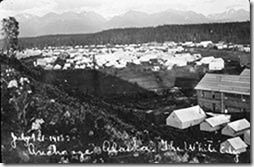
In 1915, the bustling metropolis that we visited today was a scramble of tents at the end of Cook Inlet (photo from wikipedia). With pretty much its only purpose in life to be support for the railroad, the company town of 3,000 souls kept a low profile for decades.
Then along came World War II, the Cold War, and Big Oil. And nothing was ever the same. From 3,000 to 47,000 through WW2 and the Alaska Highway, then with huge military and resource investments ($8B for the Pipeline alone), Anchorage became a Presence in the north unlike any other. The big ‘quake of 1964 could have been a huge setback. I was stationed at Elmendorf AFB in 1967, and saw the rubble-strewn shambles of the city center. But the plucky town rebuilt itself, kept on going, and grew to the 300,000 residents of today — nearly half the entire state’s population. My friend who lives in an Anchorage suburb remembers dark, mysterious hills above the city from forty years ago – hills that are now studded with the twinkling lights of hundreds, perhaps thousands, of homes.
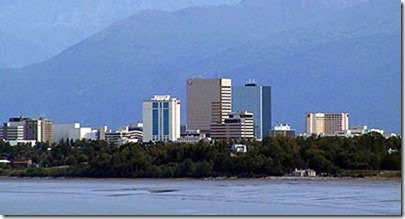
Perhaps due to concerns of future quakes, there aren’t too many high-rises in Anchorage, and they don’t rise all that high. This is a shot of the downtown area on a clear day (thanks again wiki), showing the biggest buildings. Most of the town is down below a handful of stories.
As we traveled toward Anchorage, moving down from the sparsely settled areas in the north, it was quickly apparent that we were on the way to a major population center. Roads became wider, smoother, faster. Side roads turned from dirt to paved. Phone poles and wires began “decorating” the landscape in all directions. We even acquired a cell phone connection! The unmistakable print of Man was clearly on the land.
Today, at ten times the population of Juneau, Fairbanks, or Whitehorse, Anchorage is the 800-pound gorilla of northern North America. It also has all of the trappings of any other big city: opulent neighborhoods and trashy ones, freeways and traffic jams, Home Depot’s and high prices. Especially high prices. Transporting stuff all the way up here doesn’t happen for free, and the costs pass on to the end consumer for nearly every commodity. I priced an automotive part at O’Reilly in San Jose at $134, and found it up here at Anchorage O’Reilly at $236.
Different parts of the city are striking, in very different ways. Coming in from the north on AK-2, the Chugach Mountain range dominates the entire skyline.
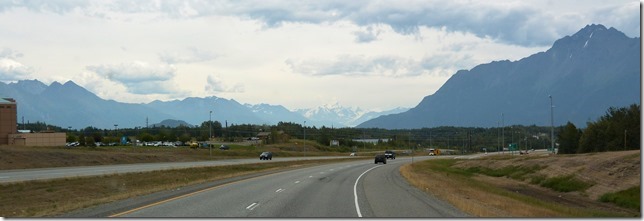
Further south, one of the first edge-of-town impressions is the miles upon miles of three-strand barb wire atop the eight-foot fence enclosing the military base. Later, the freeway turns into the typical stop lights and one-way streets of down-town, familiar to locals and confusing to visitors.
In a section near the southern end of town, we stopped one day for some quick grocery shopping in a small suburban neighborhood. As we got out of the truck, we couldn’t help but notice the rag-tag cars that shared the parking lot with us, drooling their ongoing contributions to the greasy splotches between the faded white lines. The tattoo folks next door were outside, taking a smoke break, sizing us up as we ventured toward the market. The overall impression was completed by two panhandlers at each of the two market-entry doors, hitting us up for “spare change”. Like I say, all kinds of neighborhoods.
True to form, the Gorilla has a broad variety of services and providers to choose from. Finally, we could get some of the foods we need, or have come to prefer, which were totally lacking in Canada and even Fairbanks. I was able to get a new filter for my camera, exactly the right size and top brand. And Karin had her choice of no less than eight Catholic churches to attend mass. Markets, churches, parts and hardware stores, that’s what cities are for (as far as we’re concerned), and they’re here a-plenty.
The offshoot of all this commercial success is a resident throng of people, and similar throngs of visiting tourists, all available to participate in some of the richest natural wonders to be found anywhere. And the predictable result is some pretty significant crowding. We are just beginning our exploration of the Kenai peninsula, and we find repeatedly that substantial crowds are here to share the experience with us. Camp sites full on weekday afternoons (unheard of), scenic spots that must be photographed with strangers in them (because there is always somebody there). Pretty mountain streams with more fishermen than fish, like Bird Creek just south on the Seward highway. Ah, the peace and joy of fishing a wild stream….
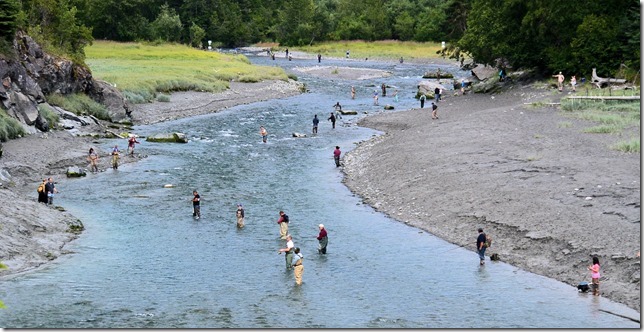
This is not an uncommon problem, and similar conditions can be found at many other “popular attractions”. Try to get a camp site at Yellowstone, Grand Canyon, or Yosemite during peak summer weeks. Ha.
For this reason, we normally avoid traveling during the mid-summer months, and we try to do our tourism in the “shoulder” seasons of Spring and Fall. But there’s a catch. Up here, above 60 degrees north latitude, Spring and Fall tend to be Cold and White. And don’t forget the time needed to drive back and forth, at least ten driving days in each direction. Poor Howie’s water system would simply freeze solid. So here, if we want to travel like the wimpy Californians that we are, well it’s going to have to be summertime. Looking around, there appear to be a lot of people who feel the same way.
Crowds don’t dampen the Alaskan sense of humor. Here’s the advertising for the roadside Pit BBQ situated on the north shore of the bay known as Turnagain Arm.
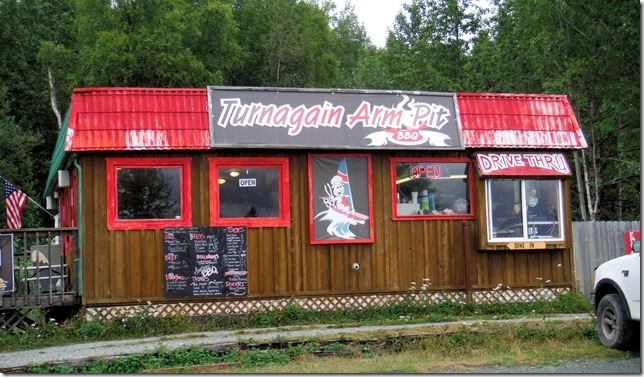
Crowds notwithstanding, Anchorage is very unique from its other jam-packed cousins. Just outside town (and sometimes even inside town), the wild part of Alaska takes over very quickly. In the hills south of San Jose, timid little blacktail deer will occasionally browse our backyard landscape. In Anchorage, the landscape-muncher is an 800-pound moose. The Chugach National Forest sits at the edge of town, and it’s as if San Jose had its edge at the foot of the Sierra Nevada mountains. From urban to wilderness in a quarter mile.
Go south from Anchorage a bit and hit the incredible Kenai peninsula. Go north and you’re at the Alaska Range and Denali. East and West take you to other wild and wooly areas. This easy-access is a huge contributor to the popularity of Anchorage for tourism, because it’s so simple to get to really unique, beautiful, and wild places. About 200 miles in some direction will take us to mountains, rivers, glaciers, lakes, oceans, fjords, moose, bears, otters, seals, of course oceans, and just about everything except rattlesnakes. (Kinda nice not having to worry about rattlers up here.)
Almost everyone knows about the Iditarod trail, world-famous for the 1000+ miles of dog-sled racing every year. But the Iditarod began life as different pieces, all of them gold-seeker trails. Once upon a time, men dragged sleds across muskeg and glaciers, packed through mountains and forests, and boated up bays and fjords to get across this region. The Seward and Sterling highways now make such travel easy on the Kenai, and possible for the likes of you and me. This Seward stretch, along the north shore of Turnagain Arm, looks so smooth and beautiful that it easily conceals the extraordinary travel hardships that preceded it.
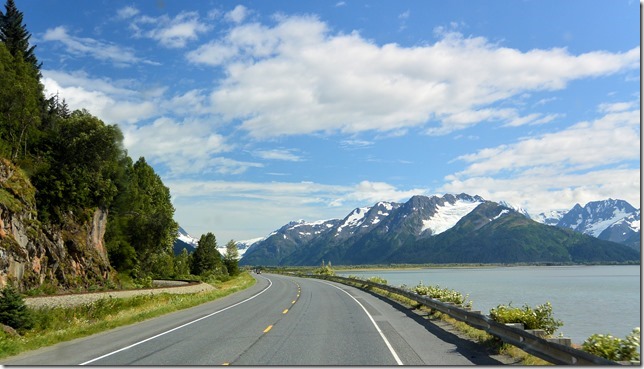
Here’s a section of the road, showing the massive pieces of rock-mountain removed. The vertical lines are drill-holes where the dynamite was packed in and detonated to blow the rock apart. Just one of many areas which enable the road’s existence.
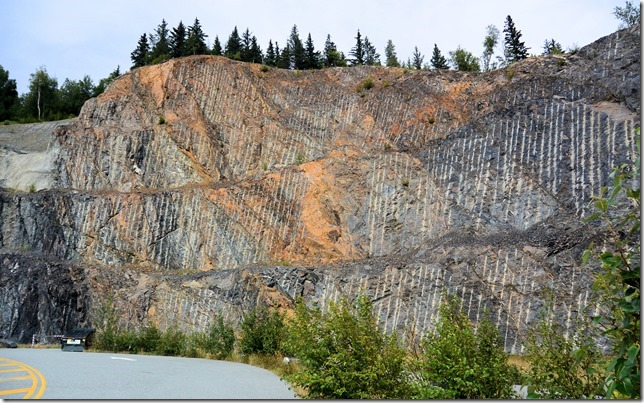
So we are re-supplied, and leaving Anchorage for the Kenai: Portage, Seward, Soldotna, Homer, and other points southwest. First stop will be the Portage Valley. Lots of rain in the forecast, so don’t be disappointed with the gray photos.

If you get to Homer your gotta check out the Homer Spit…Not really much on scenery(,dirt and gift shops,) but seems to be mentioned in so many RV blogs.Dont really know why it is so popular ….I was there because the Alaska Marine Highway Ferry stops there for a day. In Whittier there are some huge multistoried grey abandoned buildings (from WWII I was told) beside the port.and railroad yards…Whittier seems to be a busy port, not meant for tourists.but maybe more “real Alaska”.
.I am enjoying very much your detail and history and photos….keep ’em coming…Just gotta add my 2 cents so you’ll know we are out here reading your excellent posts and not just “lurking”.
We are looking forward to camping on the spit, probably for just one night. It’s pretty much shoulder-to-shoulder, but what a hoot. Also, we did get out to Whittier, pretty interesting place. Those buildings were a military “city” back in the day — more on those in a later post.
Thanks for reading….